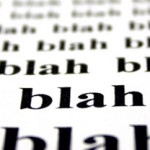Verbal language and visual design. They have much in common within the umbrella of communication, for they both can be executed in very stylized ways. They can be forthright. They can say things without saying things. They can tug on emotions. A pun can be word based or image based. If I’m frustrated, I can let you know that with very abstract speech. Let’s call it an emphatic, prolonged grunt/sigh. A series of high-contrast, rushed brush strokes colliding into one another may suggest the same feeling. Take away the contrast. The brush strokes are now a variation of the same tone. It may still say frustration, but in a different way. Perhaps now it says confusion or despair. And while it’s true that my image may be worth a thousand words, I want the viewer to leave with an understandable, meaningful, and concise message.
Audial/speech communication is something we constantly practice, to the point that we barely think about it. We’ve encountered it from the day we were born, and we quickly exercised our own skills. We’re picking and choosing various elements and methods to make our point or need known.
Visual design isn’t quite as ingrained, though it is experienced on a regular basis, largely through advertising. And while the practice of design is similar to the audial in that we choose elements and styles and combine them, it’s something we rarely do without a concerted effort.
Whether done naturally as a part of everyday living, or done as a sit-down, concerted effort, communication is a creative process. And when it comes down to design, we quickly see that the details matters. Fonts are like emotions. Visual movements are gestures. Colors are moods. Line is pitch. Size is volume. Variation is tone.
Or not.
Those are rules of thumb. The nuances of visual design are pliable. They can be pulled and twisted to create irony or a visual pun. They can present the viewer with sarcasm. Regardless, they form meaning. That meaning can still be delivered even if the elements are not cohesive, though it will lack impact. It can be delivered in an over-the-top manner that tries to make maximum use of too many elements, though it will lack focus. Or, it can be delivered with a balanced dose of creativity that has focused meaning and will stick in one’s memory.
Find good examples of design and ask yourself why they work. Then practice, recognize when you fail, and determine why it is you failed. Then keep putting design into practice and embrace and enjoy the challenge of the puzzles you encounter. When your viewer walks away from your creation, may they easily grasp and retain the concise message. Nobody remembers one thousand words.



